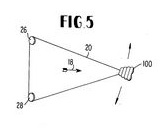5.75 kW is the average value given on the table 8. So Pierre considers nothing for that. From this value it is not too difficult to deduce that a similar 200 m² power kite would be a 60-100 kW unit at 10 m/s wind speed, and 100-170 kW at 12 m/s wind speed.
Other arrangements such like  (US3987987 Fig. 5) do not change the fact that the kite generates power when going downwind, flying crosswind or not, with reel or with pulleys.
(US3987987 Fig. 5) do not change the fact that the kite generates power when going downwind, flying crosswind or not, with reel or with pulleys.